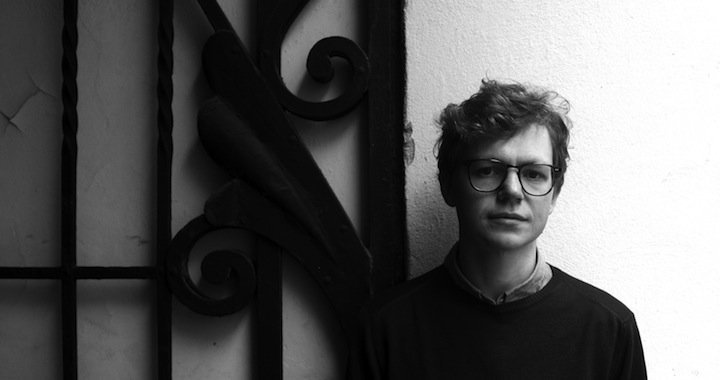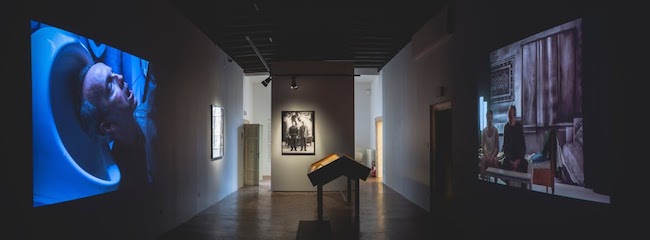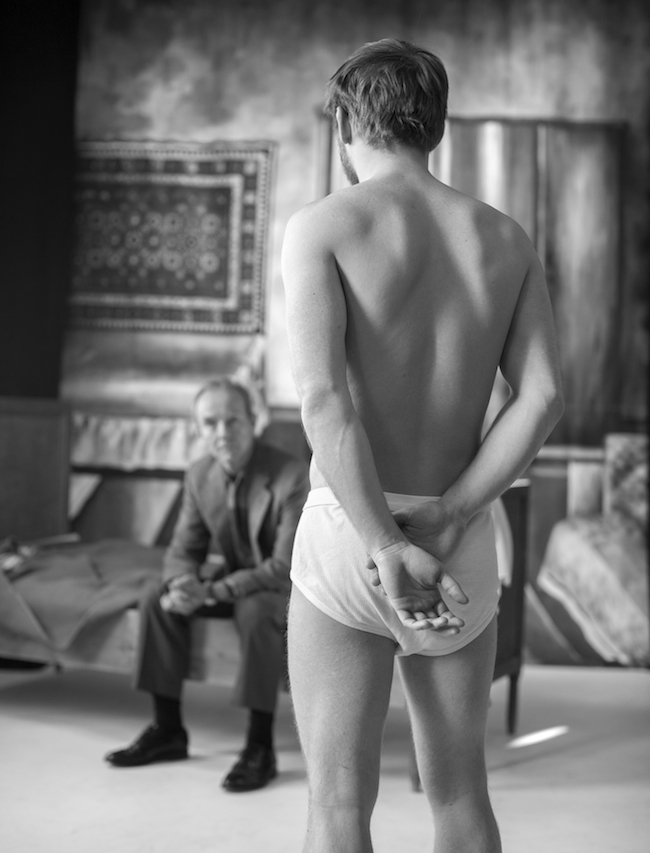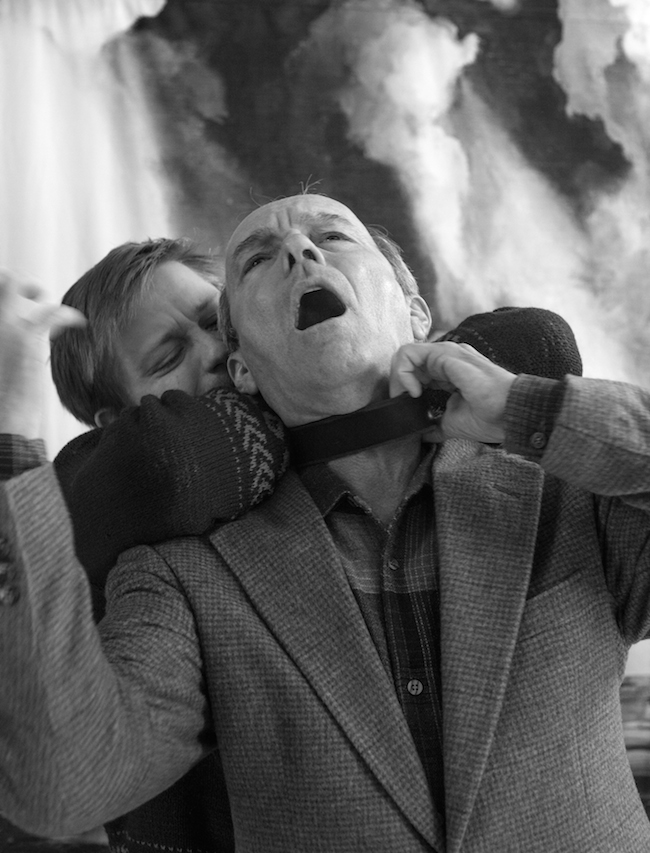
A Chairman’s Tale in Venice
Jaanus Samma on his “NSFW. A Chairman’s Tale” Estonian Pavilion in Venice Biennale
Sheena Malone
02/07/2015
At the 56th Venice Biennale, Estonian artist Jaanus Samma expands on the story he first broached in “Chairman. The Opera”, a work which received the both the Köler Prize and the People’s Choice Award in 2013. Taking the real-life biography of the “Chairman”, a name given to a notorious gay man in Tartu, Samma creates “NSFW. A Chairman’s Tale” that combines installation, documents, archive photos, film and photographs. The “Chairman” of Samma’s tale is “Juhan Ojaste” (1921-1990), a war hero and “family man” whose nickname derived from his position on a kolkhoz (a collective farm) in Soviet Estonia. In 1964, due to his involvement in homosexual acts which were criminalized during this period, he was arrested and expelled from the Communist Party, enduring a degrading trial followed by a prison sentence. In the exhibition, Samma places the visitor in an active position that requires them to play a multitude of roles that simultaneously spy upon, judge, condemn and empathise with the “Chairman” making for uncomfortable but necessary viewing.
Over the last number of years Samma has been exploring micro-histories pertaining to homosexual culture in the Soviet-era Estonia, developing a body of work that has consolidated his position as one of the most exciting artists to emerge from the country. In his practice, Samma employs research, documents and archival sources blending this material with elements of subjectivity and his artistic perspective. In 2011, an audio collection entitled “Stories” charted the oral history of gay sexual life and social practices in the 70s and 80s Estonia. Highlighting the necessary clandestine nature of these social gatherings, the project “AAFAGC” (Applied Art for A Gay Club) took the form of six short scenes depicting labouring men carrying out tasks in rural setting, with the premise that these videos were primarily meant to be shown in the gay club environment.
“NSFW. A Chairman’s Tale” is housed at the Estonian Pavilion, tucked away down the winding side-streets that lead from Campo Santo Stefano. Some of the Biennale visitors may find it perhaps a little off the usual and well-worn Biennale path; however, those that do make the trek are rewarded with a superb exhibition that should not be missed. To find out a little more about the ideas behind the show, I spoke to Jaanus Samma.

Installation view NSFW. A Chairman's Tale. Photo by Reimo Võsa-Tangsoo
How does it feel to represent Estonia at the Venice Biennale? Do you approach it as you would any other exhibition or are there specific problems or challenges to consider related to mounting an exhibition on this worldwide stage?
I have tried not to think that I’m representing my country because in my mind I represent myself, not the country. But concerning the worldwide stage – yes, I thought it was necessary to open up the context a bit about Soviet Estonia and life in a kolkhoz. At the same time I have tried to use fragments from the Chairman’s story that are universal and not just specific to the Soviet period. For example, the scene in the public toilet illustrates the gay cruising culture in general very well.
In this exhibition “NSFW. A Chairman’s Tale” you present the story of “Juhan Ojaste” (1921-1990), whose name you change and disguise in photographs for privacy reasons. You have previously been awarded the Köler Prize in 2013 for “Chairman. The Opera”, which can be seen as a precursor to this exhibition. Can you tell us a little about the Chairman and what attracted you to telling his story?
In 2011 I started my research on homosexuality in Soviet Estonia. I did many interviews and heard many interesting stories. Several informants talked vividly about a guy called the Chairman. I found his life to be an extremely interesting case – in a way the very quintessence of the Soviet gay man.
I wanted to talk about Paragraph 118 that criminalised homosexuality, about cruising, about violence against sexual minorities, etc., and his life covered most of the topics I wanted to underline.
Of course, I have interpreted the materials quite freely, changed details, added things and events that weren’t directly connected with the Chairman, but it is not important for me, because I am not interested in him as a real person. I am interested in the bigger story of individual struggle in a system where a person cannot be free.

3.50 (From A Chairman’s Tale series), 2015, pigment print, 120 x 92cm
The acronym NSFW (not suitable for work) is a very contemporary term. It could also be described as being open to interpretation. What where your particular reasons for choosing the title?
We wanted to play on the words, so, on the one hand, it can refer to sexually explicit materials but also describes well the Chairman’s position in the society. He literally was not suitable for work and lost his position as the kolkhoz chairman because gay sex was illegal at the time. And since the bigger aim of the show is looking not only at the past but also at the future, we thought it would be good to use a contemporary term.
For the last few years, you have been working with the hidden stories of criminalized gay culture in the Soviet-era Estonia. When working with historical archival material, do you feel an added pressure to be respectful of the subject or do you remain as objective as possible throughout the process?
Mixing research and art is an excuse for not being objective. But of course in my research I had to tackle many ethical questions because I deal with contemporary history, events that happened only a few decades ago. It has raised many interesting questions, for example, whom these stories belong to. Are they personal stories that we shouldn’t expose or are they part of a subcultural identity that is shared collectively?
In visiting the exhibition, I am reminded of Hal Foster’s “archival impulse”. How do you approach this material and what is your working process regarding it? Does it become clear during the research process through what media the story needs to be told?
I wanted to add some sort of shift and not to make it too documental. I decided to tell the story through a play where audience can experience different elements of that story separately. So for example, I have a showcase with the props appearing in the videos and the sound in the Loge. The Loge is crucial in the exhibition as a place where it all comes together: a meditative space.
In your practice, do you feel a responsibility to uncover and shed light on injustices? If we whitewash the past in an effort to concentrate on achieving a more equal society, do we risk forgetting our past mistakes and the lessons we should have learned from them?
I think we should also talk about the things that people want to forget. I found it important to ask difficult questions about our collective past and then to try to find the answers together.
The exhibition is beautifully choreographed, taking the visitor through a narrative that incorporates documents, photographs, objects, films and a sound installation set in an opulent opera loge. How did you work together with curator Eugenio Viola to tell the Chairman’s story? Had you worked together previously?
Thank you! I met Eugenio in Tallinn in 2013 where he was in an award jury and I was one of the nominees. We didn't talk much at the time but I looked him up later and proposed to do the Estonian pavilion open call application together. Since we didn’t know each other’s personalities and working methods, we both took a risk but it was worth it since the collaboration worked out very well. We had, of course, different understanding of some things, but this is actually what collaboration is all about – both parties make sacrifices for the higher cause. And in the end you both have learned something new.

Public Toilet (From A Chairman’s Tale series), 2015, pigment print, 120 x 92cm
The films (“3.50 Roubles”, “Public Toilet” and “The Trial”) provide a nice counterpoint to the historical material (which the exhibition publication describes using Allan Sekula’s distinctions of “instrumental” and “documentary”). Through the use of painted backgrounds, on-screen text and the actors’ glances towards camera, we are constantly reminded that what we are watching is a reconstruction. Was it important for you that this distinction was made clear?
The audience should not feel too comfortable at the exhibition. The videos should not only remind that it is a reconstruction but also make visitors aware of their presence. It is a play, a performance with a voyeuristic audience.
The role of the viewer in the exhibition should not be neglected. As a visitor you move from being an investigator to voyeur to judge. The evidence is presented for us to read and objects and films are there for us to view and judge. Did you intend for the viewer to play this kind of active role where it feels as we are complicit with the authorities in putting the actors on trial?
Indeed, in one of the scenes where the actors are assuming various sexual positions, they are looking into the camera to make it clear that You are watching Them. It is an illustration of the situation when someone’s private life becomes a state matter. I hope the audience can feel the disturbing unease it causes to everyone involved.
In each film, the same two actors appear: an older man plays “Juhan Ojaste” while a handsome innocent-looking youth plays his lover. The power balance is not quite as you would expect. Generally we associate youth with rebellion and non-conformity but here we see the younger man delivering the sentence and punishment, therefore maintaining the status quo of the general public. It felt quite pessimistic in a way…

Trial #2 (From A Chairman’s Tale series), 2015, pigment print, 120 x 92cm

Trial #3 (From A Chairman’s Tale series), 2015, pigment print, 120 x 92cm

Trial #4 (From A Chairman’s Tale series), 2015, pigment print, 120 x 92cm

Trial #5 (From A Chairman’s Tale series), 2015, pigment print, 120 x 92cm
It’s an interesting remark, I had not thought about it this way. The age difference is inspired by the Chairman’s life story. He was put on trial for homosexual acts because his younger lover exposed him to the police. Actually the younger actor plays several different roles all compressed into one and they don’t always conform to what we would expect.
The actor who plays the Chairman had to appear in some gruesome scenes in the films, which at times can be quite uncomfortable to watch. While making the films, you also worked with the filmmaker Marko Raat. How did you prepare and direct the actors?
I made the videos with my friend Marko Raat. He was the director and also wrote the final script, which was based on the discussions we had and my initial idea. I had already worked with the French/Danish artist Al Masson before and I also knew Simeoni Sundja a little, so it was easy to work with a team I knew beforehand. Especially with difficult scenes, it is important to trust the other team members.

Forensic Medical Examination #1 (From A Chairman’s Tale series), 2015, pigment print, 120 x 92cm
And finally, for those who are unable to make it to Venice, will “NSFW. A Chairman’s Tale” be shown again at another venue or do you have more exhibitions planned for the future?
Hopefully it will move on. It will definitely be shown in Estonia, but we are discussing other proposals and possibilities. Regarding this particular exhibition, I feel that the context of the place and the country where it will be shown should also be taken into consideration, and I might do some small changes to adjust it. My aim is for the show to raise questions about the past and the future, and therefore I have to modify it according to the context in order to make it work better.